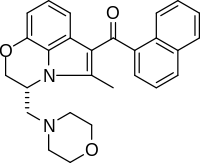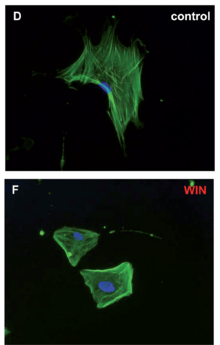WIN 55,212-2
WIN 55,212-2 is a chemical described as an aminoalkylindole derivative, which produces effects similar to those of cannabinoids such as tetrahydrocannabinol (THC) but has an entirely different chemical structure.[3][4][5]
 | |
| Legal status | |
|---|---|
| Legal status |
|
| Identifiers | |
| |
| CAS Number | |
| PubChem CID | |
| IUPHAR/BPS | |
| ChemSpider | |
| UNII | |
| ChEBI | |
| ChEMBL | |
| CompTox Dashboard (EPA) | |
| Chemical and physical data | |
| Formula | C27H26N2O3 |
| Molar mass | 426.516 g·mol−1 |
| 3D model (JSmol) | |
| |
| |
| | |

WIN 55,212-2 is a potent cannabinoid receptor agonist[6] that has been found to be a potent analgesic[7] in a rat model of neuropathic pain.[8] It activates p42 and p44 MAP kinase via receptor-mediated signaling.[9]
At 5 μM WIN 55,212-2 inhibits ATP production in sperm in a CB1 receptor-dependent fashion.[10]
WIN 55,212-2, along with HU-210 and JWH-133, may prevent the inflammation caused by amyloid beta proteins involved in Alzheimer's disease, in addition to preventing cognitive impairment and loss of neuronal markers. This anti-inflammatory action is induced through agonist action at cannabinoid receptors, which prevents microglial activation that elicits the inflammation. Additionally, cannabinoids completely abolish neurotoxicity related to microglial activation in rat models.
WIN 55,212-2 is a full agonist at the CB1 cannabinoid receptor (Ki = 1.9 nM) and has much higher affinity than THC (Ki = 41 nM) for this receptor.[11] WIN 55,212-2 is also an agonist of the PPARα and PPARγ nuclear receptors.[12]
WIN 55,212-2 reduces voluntary wheel running in laboratory mice, but with effects that depend on both genetic background and sex.[13]
In the United States, all CB1 receptor agonists of the 3-(1-naphthoyl)indole class such as WIN 55,212-2 are Schedule I Controlled Substances.[14] WIN 55,212-2 is illegal in the UK.[15]
See also
- WIN 48,098 (Pravadoline)
- WIN 54,461 (6-Bromopravadoline)
- WIN 55,225 (JWH-200)
- WIN 56,098
References
- "Controlled Drugs and Substance Act - Schedule II". Justice Laws Website. Government of Canada.
- Michalski CW, Maier M, Erkan M, Sauliunaite D, Bergmann F, Pacher P, et al. (February 2008). Gluud C (ed.). "Cannabinoids reduce markers of inflammation and fibrosis in pancreatic stellate cells". PLOS ONE. 3 (2): e1701. Bibcode:2008PLoSO...3.1701M. doi:10.1371/journal.pone.0001701. PMC 2253501. PMID 18301776.
- Compton DR, Gold LH, Ward SJ, Balster RL, Martin BR (1992). "Aminoalkylindole Analogs: Cannabimimetic Activity of a Class of Compounds Structurally Distinct from Δ9-Tetrahydrocannabinol". Journal of Pharmacology and Experimental Therapeutics. 263 (3): 1118–1126. PMID 1335057.
- Ferraro L, Tomasini MC, Gessa GL, Bebe BW, Tanganelli S, Antonelli T (August 2001). "The cannabinoid receptor agonist WIN 55,212-2 regulates glutamate transmission in rat cerebral cortex: an in vivo and in vitro study". Cerebral Cortex. 11 (8): 728–33. doi:10.1093/cercor/11.8.728. PMID 11459762.
- Zhang Q, Ma P, Iszard M, Cole RB, Wang W, Wang G (October 2002). "In vitro metabolism of R(+)-[2,3-dihydro-5-methyl-3-[(morpholinyl)methyl]pyrrolo [1,2,3-de]1,4-benzoxazinyl]-(1-naphthalenyl) methanone mesylate, a cannabinoid receptor agonist". Drug Metabolism and Disposition. 30 (10): 1077–86. doi:10.1124/dmd.30.10.1077. PMID 12228183.
- Felder CC, Joyce KE, Briley EM, Mansouri J, Mackie K, Blond O, et al. (September 1995). "Comparison of the pharmacology and signal transduction of the human cannabinoid CB1 and CB2 receptors". Molecular Pharmacology. 48 (3): 443–50. PMID 7565624.
- Meng ID, Manning BH, Martin WJ, Fields HL (September 1998). "An analgesia circuit activated by cannabinoids". Nature. 395 (6700): 381–3. Bibcode:1998Natur.395..381M. doi:10.1038/26481. PMID 9759727. S2CID 1619608.
- Herzberg U, Eliav E, Bennett GJ, Kopin IJ (January 1997). "The analgesic effects of R(+)-WIN 55,212-2 mesylate, a high affinity cannabinoid agonist, in a rat model of neuropathic pain". Neuroscience Letters. 221 (2–3): 157–60. doi:10.1016/S0304-3940(96)13308-5. PMID 9121688. S2CID 33643599.
- Bouaboula M, Poinot-Chazel C, Bourrié B, Canat X, Calandra B, Rinaldi-Carmona M, et al. (December 1995). "Activation of mitogen-activated protein kinases by stimulation of the central cannabinoid receptor CB1". The Biochemical Journal. 312 ( Pt 2) (Pt 2): 637–41. doi:10.1042/bj3120637. PMC 1136308. PMID 8526880.
- Morgan DJ, Muller CH, Murataeva NA, Davis BJ, Mackie K (April 2012). "Δ9-Tetrahydrocannabinol (Δ9-THC) attenuates mouse sperm motility and male fecundity". British Journal of Pharmacology. 165 (8): 2575–83. doi:10.1111/j.1476-5381.2011.01506.x. PMC 3423255. PMID 21615727.
- Kuster JE, Stevenson JI, Ward SJ, D'Ambra TE, Haycock DA (March 1993). "Aminoalkylindole binding in rat cerebellum: selective displacement by natural and synthetic cannabinoids". The Journal of Pharmacology and Experimental Therapeutics. 264 (3): 1352–63. PMID 8450470.
- O'Sullivan SE (June 2016). "An update on PPAR activation by cannabinoids". British Journal of Pharmacology. 173 (12): 1899–910. doi:10.1111/bph.13497. PMC 4882496. PMID 27077495.
- Keeney BK, Meek TH, Middleton KM, Holness LF, Garland T (June 2012). "Sex differences in cannabinoid receptor-1 (CB1) pharmacology in mice selectively bred for high voluntary wheel-running behavior". Pharmacology, Biochemistry, and Behavior. 101 (4): 528–37. doi:10.1016/j.pbb.2012.02.017. PMID 22405775. S2CID 25174208.
- : Schedules of controlled substances
- "The Misuse of Drugs Act 1971 (Amendment) Order 2013". legislation.gov.uk.
Further reading
- Patwardhan AM, Jeske NA, Price TJ, Gamper N, Akopian AN, Hargreaves KM (July 2006). "The cannabinoid WIN 55,212-2 inhibits transient receptor potential vanilloid 1 (TRPV1) and evokes peripheral antihyperalgesia via calcineurin". Proceedings of the National Academy of Sciences of the United States of America. 103 (30): 11393–8. Bibcode:2006PNAS..10311393P. doi:10.1073/pnas.0603861103. PMC 1544096. PMID 16849427.
- Ramírez BG, Blázquez C, Gómez del Pulgar T, Guzmán M, de Ceballos ML (February 2005). "Prevention of Alzheimer's disease pathology by cannabinoids: neuroprotection mediated by blockade of microglial activation". The Journal of Neuroscience. 25 (8): 1904–13. doi:10.1523/JNEUROSCI.4540-04.2005. PMC 6726060. PMID 15728830.
External links
- "Win 55,212-2 Data Sheet". Enzo Life Sciences.